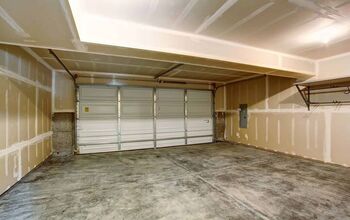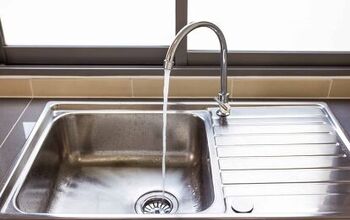How To Fix A Clogged Propane Torch (A Step-by-Step Guide)

Torches have been used for centuries, and while their design might have changed, the truth is that they still remain a major part of our day to day lives. The most common type of torch used today is a propane torch, and they’re reliable…for the most part. Once in a while, your torch might end up getting a clog in it. When this happens, you’re going to have to find a solution.
To clean a clog out of a propane torch, you will need to remove the nozzle and boil it in water. Once it’s thoroughly boiled, the residue in the torch should come out of its own accord. Take the nozzle out, let it dry, and then reattach it to your torch to complete your de-clogging.
If you’re worried about being able to complete that last project without a torch in your hand, stop panicking. This guide will help you make your torch clog-free and ready to fire up in no time.
Do You Need to Hire a Professional Welder?
Get free, zero-commitment quotes from pro contractors near you.

Why Do Torch Clogs Happen?
Though propane is a remarkably clean-burning fuel, it still can still cause some residue to build up from time to time. This can be due to impurities in the air (smoke) or just from having fuel that’s combined with the flame clog up the nozzle. Things like solder, plant debris, and even soot can all clog up a torch.
If you thought that your torch got clogged due to overuse, don’t. Among crafters who use torches, a common complaint is that it almost seems like torches build up residue even when they’re not in use. Besides, it’s fairly easy to get rid of a clog in a torch as long as you know how.
How Do You Repair A Clogged Propane Torch?
A clogged propane torch only needs to be cleaned in order for it to be a workable piece of equipment again. This won’t take much aside from a pot, some water, a stovetop, and a little patience. Here’s how to do it.
- Fill a medium-sized pot three-quarter of the way up with water. Turn the heat on your stove up to high, and get that water heated up.
- Remove your propane torch nozzle. You can do this by grabbing the nozzle and rotating it counterclockwise to unscrew it. Once it’s loosened up, gently pull it off the torch.
- Place the nozzle in the water and let it boil for approximately 10 minutes. The high heat of the boiling water will break down the compounds that caused a clog in your nozzle while also keeping your propane torch nozzle sanitized. It’s a win-win.
- Using a pair of tongs, fish out the nozzle and place it on a drying mat. Do not touch the nozzle, as it is extremely hot and will likely cause you to get burned. Pour the water in the pot out, and turn off the stove. Prior to using that pot for food, make sure that you give it a thorough cleaning.
- Once the nozzle is cool to the touch, grab it and shake it a couple of times. This will get the water out of the inside of the nozzle. Then, use a rag to pat the nozzle dry.
- Reattach the propane nozzle to the rest of your torch rig. To do this, insert the nozzle in its regular position and rotate clockwise until it’s tightly attached. Congrats! You now have an unclogged torch.
What If My Torch Nozzle Is Still Clogged?
While most clogs will be able to be removed through the boiling method, there are some clogs that are a little too stubborn for boiling alone. It happens, and when it does, there is another way that you can work around this. What you need to do is the following:
- After you’ve boiled your nozzle, dip a small pipe cleaner in dish detergent and use the pipe cleaner to scrub away the debris inside the nozzle. If your nozzle is completely blocked, keep going. It may take five minutes of scrubbing to get through, but you will be able to get some penetration soon enough.
- Let the detergent sit inside the nozzle for five to 10 minutes. The degreasing agents in dish detergent will further break down any clogs and residue that might be inside the nozzle.
- Grab your pipe cleaner and keep scrubbing. Once you’ve let the torch nozzle sit in detergent for a while, grab the pipe cleaner and use it to continue to scrape the sides of your nozzle. If there’s any gunk left inside your torch nozzle, it should come out with this round of scrubbing.
- Rinse the inside of your nozzle with cold water. Running a typical nozzle under a faucet will usually work. If you’re feeling particularly fastidious, then you might want to consider going for another round of boiling again.
- Shake off the extra water from the interior of the nozzle, and use a towel to pat the exterior dry. After your torch nozzle is dry, blow through it to double-check and make sure that the clog has been removed. If it has been, reattach the nozzle by twisting it clockwise onto the rest of the torch.
Is There Anything I Can Do To Prevent My Torch From Being Clogged?
In most cases, an ounce of prevention is worth a pound of cure. This is not always the case when it comes to a clogged up propane torch. The only way to reduce clogging is to avoid using it on leaves, solder, or metals…which means that many of the most common uses for a torch would be off the table. So, you’re mostly left with preventing clogs through regular cleanings.
I don’t suggest that you skip out on using a torch if you need to use one. That just defeats the purpose of owning a torch, don’t you think? Just be prepared to clean it every so often, and clogs will be less likely to occur.
Do You Need to Hire a Professional Welder?
Get free, zero-commitment quotes from pro contractors near you.

Related Questions
Why is my torch sputtering?
If your fuel is old and mixed up with oxygen, you might notice that your flame flickering, sputtering, or just acting erratically. The best thing you can do for your flame is to replace the fuel tank or “bleed out” the tank so that you can get a cleaner, more predictable light.
Can a butane tank explode?
Butane is a flammable material, and that means that you always need to exercise some level of caution when you’re using it. If handled incorrectly or not maintained well, it is possible to have a butane tank explode. This can lead to serious injury, death, as well as fires that damage property.When working with any type of butane tank, it’s vital that you exercise all the standard precautions during your work time. It could potentially save your life.
Why don’t lighters explode?
The reason why you rarely (if ever) hear about a lighter exploding is that there is no oxygen inside the fuel tank. Without oxygen present, it is not possible for combustion to happen. Without combustion inside the lighter, there’s no way for the lighter tank to explode. So, even if you have a shoddy lighter, it’s highly unlikely that you will have an explosion on your hands.
Related Guides

Ossiana Tepfenhart is an expert writer, focusing on interior design and general home tips. Writing is her life, and it's what she does best. Her interests include art and real estate investments.
More by Ossiana Tepfenhart















![Standard Dining Room Table Dimensions [for 4, 6, 8, 10 and 12 People]](https://cdn-fastly.upgradedhome.com/media/2023/07/31/9074335/standard-dining-room-table-dimensions-for-4-6-8-10-and-12-people.jpg?size=350x220)










